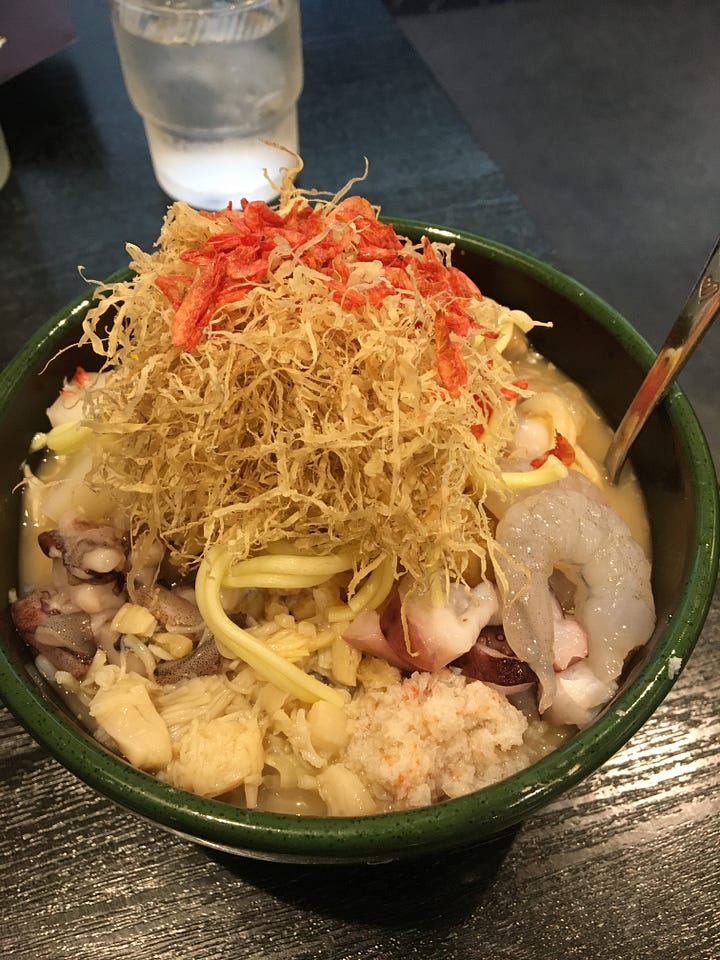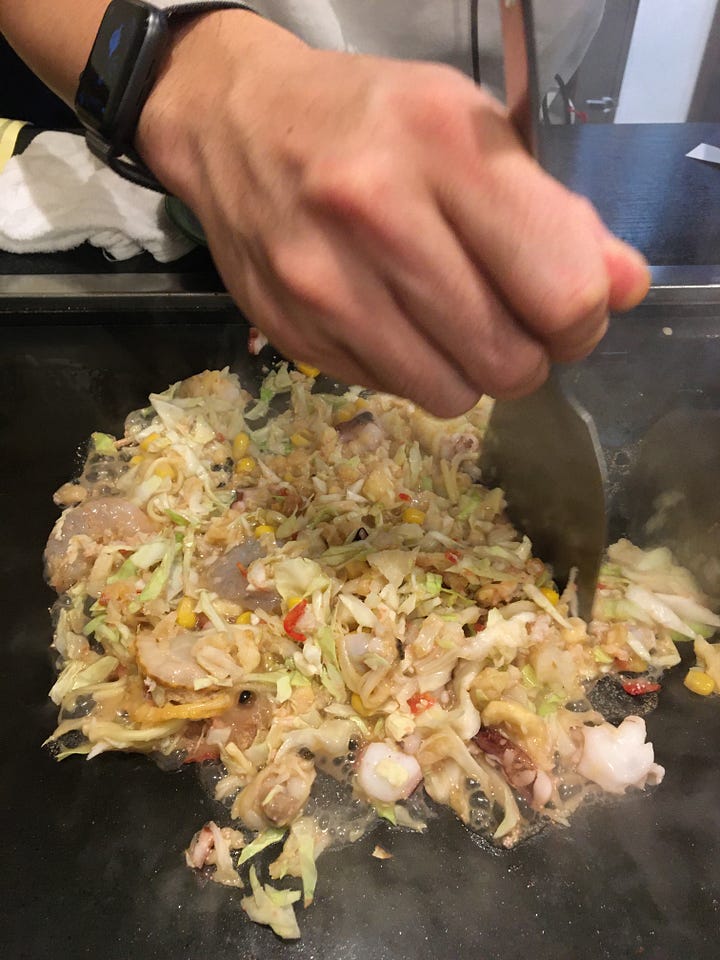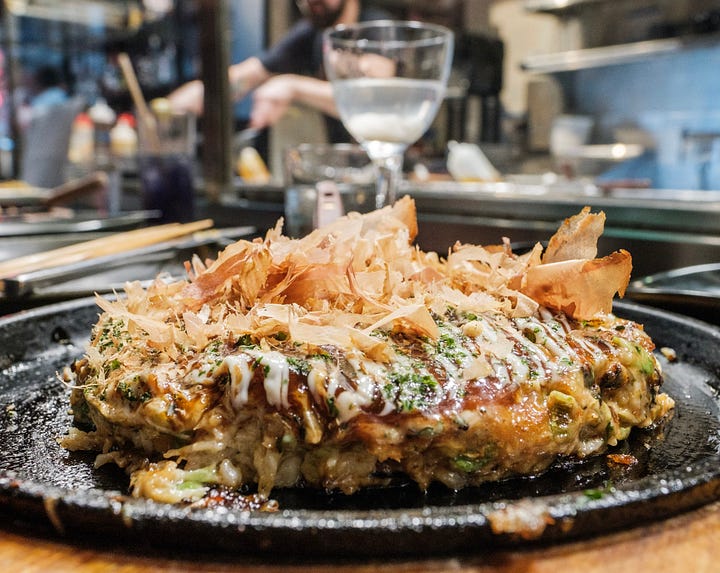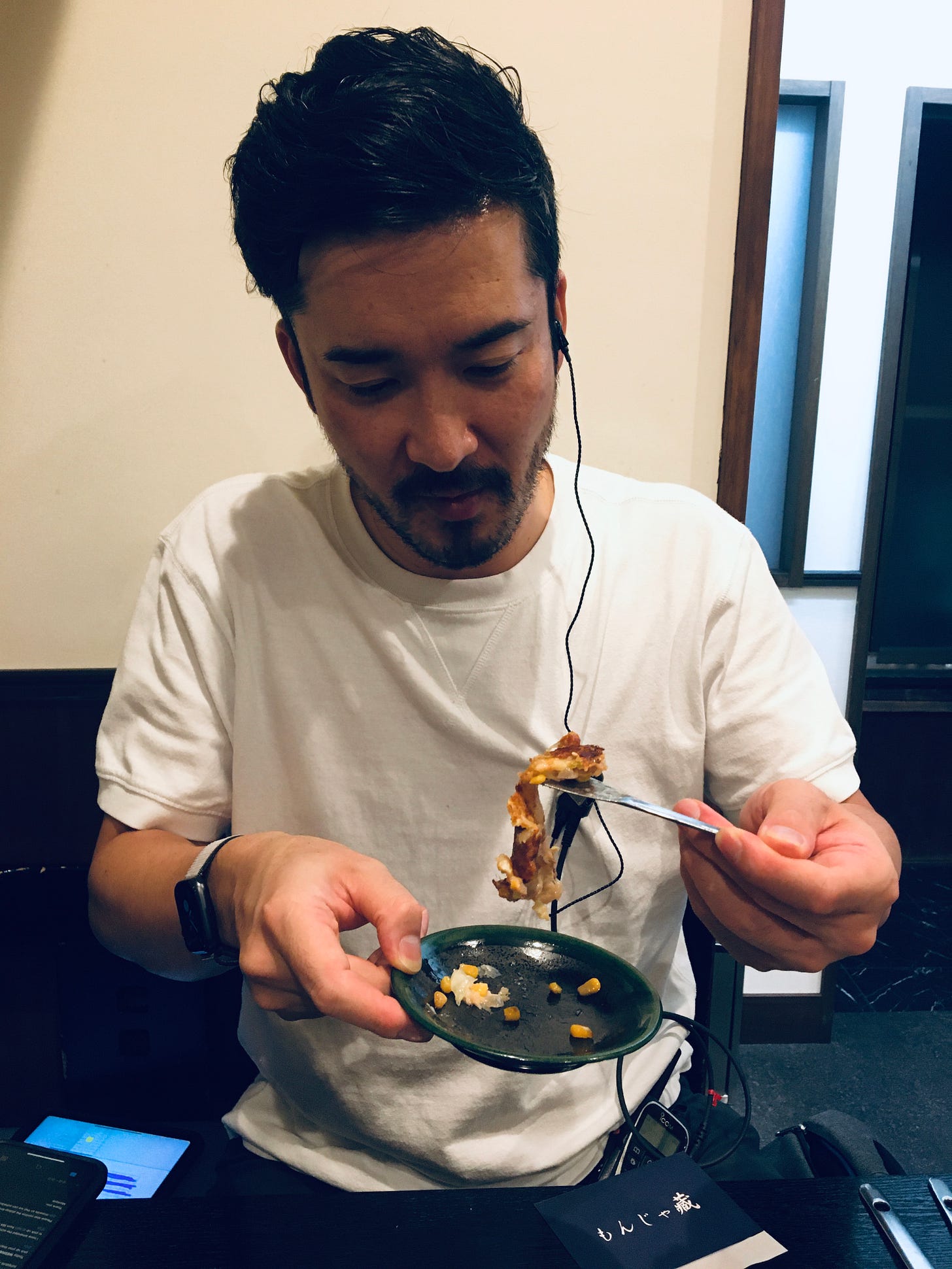Tokyo Heat Chronicles Part 2
Making Monja and a Bathroom Disaster / Bonus: Chicago’s Top Spot for Okonomiyaki
On a sweltering Tokyo midsummer day, anyone of sound mind would reach for a refreshing bowl of cold noodles, a “stamina dish” or a shaved ice treat. However, after weeks of relentless heat and humidity, I was no longer of sound mind.
That’s why on July 28, 2021 (temperature: 88 degrees; humidity: 80.5%) I opted to sit over an iron top griddle, cooking a mound of batter so unappetizing in appearance it’s been compared to “hot and sticky oatmeal” (and much worse).
My friend Bunya, who originally hails from Kōbe, had been talking-up his favorite local food monjayaki (often shortened to monja), describing it as a savory pancake similar to okonomiyaki. I had tried okonomiyaki in Chicago and loved it, so I jumped at his invitation to meet-up on Nishinaka Dori, aka Monja Street, for dinner.
I decided to tackle the three mile journey to Tsukishima—a small, man-made island in Tokyo Bay with over 70 monja restaurants and a monjayaki information office—on foot. Google said I’d arrive just in time (and Google never lies).
Five minutes into my walk I realized I was trailing a lone child, six or seven years old, sporting a Minnie Mouse face mask and an oversized backpack. With a spring in her step and bobbing pigtails, she navigated the bustling metropolis better than the bumbling American behind her.
As anyone who watches Netflix’s Old Enough! will tell you, this scenario is perfectly normal in Japan. However, as someone reared on Lifetime childhood abduction specials in 1980s America, I feared passersby would view me as some ill-intentioned creep. Anytime the girl slowed down, I stopped dead in my tracks in order to keep a safe distance.
Once she eventually turned off, I looked down at my watch and realized I was no longer on track to reach Monja Street in time. Dammit.
I HATE being late, so I accelerated to a fast clip, panting profusely under my mask and stopping periodically to guzzle water.
Not surprisingly, I developed an irrepressible urge to pee. I weighed my options: I could push through and use the restroom at the restaurant, but who’s to say there wouldn’t be a line to enter? Plus, I was so sweat-drenched that a quick stop-off before meeting Bunya wouldn’t be a bad idea.
As I crossed the bridge onto Tsukishima I spotted a park and decided to use its public restroom. I had three minutes to spare. Perfect.
I could not find the women’s restroom to save my life; I saw the men’s on one side and a single-user bathroom on the other. I was hesitant to use the single-user since the park was packed with families with young children, but I was desperate, so in I went.

A quick note about Japanese toilets: for the uninitiated, they aren’t standardized like their American counterparts. Some feature control panels rivaling that of the Apollo Command Module. Everytime I encountered a new toilet, I spent more time than I’d like to admit figuring out how to flush it.
The toilet inside the park bathroom wasn’t high tech so when I saw a lever above my head, I pulled without giving any thought.
Immediately, lights began flashing and a booming voice came over the intercom, echoing around the cinder block room. I couldn’t quite make out the message, but it was similar in tone to an end-of-days broadcast piped into a fallout shelter.
What the poop ball fuck is happening right now?!?!?!?!
Pants around my ankles, sweat dripping down my face, now late for my meet up with Bunya, I was in a full-on panic state as I attempted to pull myself together and reached for the door.
Before me: fifty some-odd parents and children stopped dead in their tracks, mouths agape.
Hearing sirens in the distance, I started bowing my head and uttering “sumimasen, daijoubu desu, daijoubu desu, sumimasen.” (“I’m sorry, I’m fine, I’m fine, I’m sorry.”)
I slowly backed away, turned on my heels and sprinted towards Monja Street.
Upon reaching Bunya, arms flailing and gasping for air, I blurted out what had happened. The sirens were wailing; they were definitely heading towards the scene of the crime.
“Shouldn’t we go back to the park and explain to the emergency responders what happened? I asked.
“No,” Bunya said, chuckling and shaking his head at the absurdity of it all, “let’s eat monja!”
Without any further discussion we stepped up to the host stand.
I’ve read that monja restaurants typically hand customers a large plastic bag upon entering for storing belongings they don’t want ruined by the overpowering aromas. I didn’t receive a bag. I assume the host took one look at me and thought, why bother?
She led us upstairs to a cooktop table and handed us menus. Flushed in the face (from the excessive humidity and the mortification), all I wanted (needed) was an ice cold beer. But Japan had banned alcohol sales in restaurants owing to the pandemic and so there was no alcohol on the menu. Gaaaaahhh.


Seeing the dissolution welling-up inside me, Bunya took charge and ordered our first round of monja. Our server set down a bowl heaped with raw ingredients—batter (a mixture of flour, dashi and seasonings), an assortment of fresh and dried seafood, shredded cheese, cabbage, corn and mochi (rice cakes).




Bunya handled the preparation: he slid the seafood and vegetables onto the teppan grill, using the large spatula to chop them into bite-sized pieces. Once cooked through, he utilized two large spatulas to form a doughnut-shaped barrier and added the liquid to its center. Then he stirred the soupy batter into the wall of ingredients before spreading the congealed mixture over the grill to crisp up.
He instructed me to grab my tiny spatula and peel off a section of the griddled batter. The prized pieces are the ones charred to a deep brown, resembling melted cheese with a delectable crust (is this the Japanese equivalent of the costra?). I loved those bites, along with the seared mochi, whose gelatinous texture became delightfully caramelized when exposed to high heat.
Bunya insisted we order a second round so that I could do the cooking. (At this point I no longer had sweat dripping off my chin so he probably considered it a safe bet). He ordered a slight permutation on the first: mentaiko (cod roe), butter, corn, cabbage, onion, tuna and shredded cheese.
Apart from the variation in color, there wasn’t much of a distinction in flavor between rounds one and two. It all coalesces into a gooey, glorious mass, no matter what’s included.
Two years on, it’s not the crust of the griddled monja but rather the image of that confident little girl and the bathroom incident that are seared in my mind.
While monja hasn’t made its way to Chicago, its more attractive cousin okonomiyaki is on a number of area menus. You can experience the best version at Gaijin, 950 W. Lake Street.


Like monja, okonomiyaki’s batter also consists of flour and dashi, however, the inclusion of grated nagaimo (yam) and eggs make it much less runny. Mixed with a mound of shredded cabbage and a variety of proteins and vegetables—okonomi means "what you like" so the permutations are endless—it takes on a true pancake form.
Gaijin’s menu offers a number of cheffed-up versions, including one with tempura fried shrimp, corn, creole butter and arare (rice cracker). On my last visit I opted for something a bit simpler: the amish chicken confit with bonito.


The quality of Gaijin’s ingredients are top-notch—chef/owner Paul Virant’s farm-to-table, seasonal approach is a throughline of all of his restaurants—so the chicken tastes like a chicken that’s lived a good life and the vegetables taste like vegetables just plucked from the garden. I love the contrast between the crispy outside and the custardy center.
Dressed with a Worcestershire-based sauce, Japanese mayonnaise and bonito flakes, it packs an umami-laced punch. Gaijin’s okonomiyaki has a complexity of flavor and visual appeal that elevates this comfort dish to new heights.
If you enjoyed this post, please forward it to someone who’d enjoy it, and tap the heart icon above or below, which will help me reach more readers. Thanks!






Forget the Monja (just kidding) the Japanese toilet story was hilarious!!! I can’t stop laughing!!!
So interesting! I’ve definitely struggled with those Japanese toilets but luckily never tripped an alarm. I’ve also tasted and made okonomiyaki but never sampled monjayaki. It sounds like it’s much the same but minus the yam and egg.